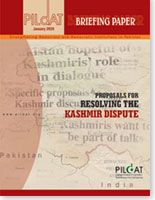Proposals for resolving the Kashmir Dispute, a briefing paper by PILDAT, was first written and published by PILDAT in June 2005. The second edition of the paper is reprinted in January 2020 in the light of the continuing siege of Jammu and Kashmir by India that began on August 5, 2019 and continues unabated in 2020. The paper is also reprinted to commemorate the January 5, 1949 resolution adopted by the United Nations Commission on India and Pakistan (UNCIP) that guarantees a free and fair plebiscite in Jammu and Kashmir to enable the Kashmiri people realize their right to selfdetermination. Over 7 decades later, the January 5, 1949 resolution serves as a critical reminder to the World to honour, uphold and implement its resolution and fulfil global responsibility towards the Kashmiri people.
On August 5, 2019, the Indian government revoked the special status accorded to Indian-administered Jammu and Kashmir in its constitution and revoked Article 370 of the Indian constitution that guaranteed special rights to the Muslim-majority state, including the right to its own constitution and autonomy to make laws on all matters except defence, communications and foreign affairs. In the lead-up to the move, India sent thousands of additional troops to the disputed region, imposed a crippling curfew, shut down telecommunications and internet, and arrested political leaders. The lockdown in Indian occupied Jammu & Kashmir reached 150 days on January 1, 2020 as over 8 million Kashmiris continued to suffer under the brutal occupation of 900,000 Indian security personnel.
This paper was first published by PILDAT to bring the debate on resolution of Kashmir problem to its legitimate place: Pakistan’s Parliament. Especially commissioned by PILDAT, the paper looked at the various proposals and options that have been floated since 1949 to resolve the issue of Kashmir. The paper brought all these proposals in a readily-accessible form as a background. Now that the condition of Kashmiris in the Indian Occupied Kashmir has deteriorated to the worst-possible depths, this paper is reprinted to show-case, once again, all the solutions that had been put forward in past 7 decades and to urge all parties to find meaningful and legitimate resolution of the Kashmir issue.
The paper was commissioned by PILDAT to compile an objective and factual commentary of the options that have been put forward by various entities, as well as trace their status. The paper’s intent was not to advocate a particular option but to present a glossary of all options for the knowledge, study and use of these for policy makers.







